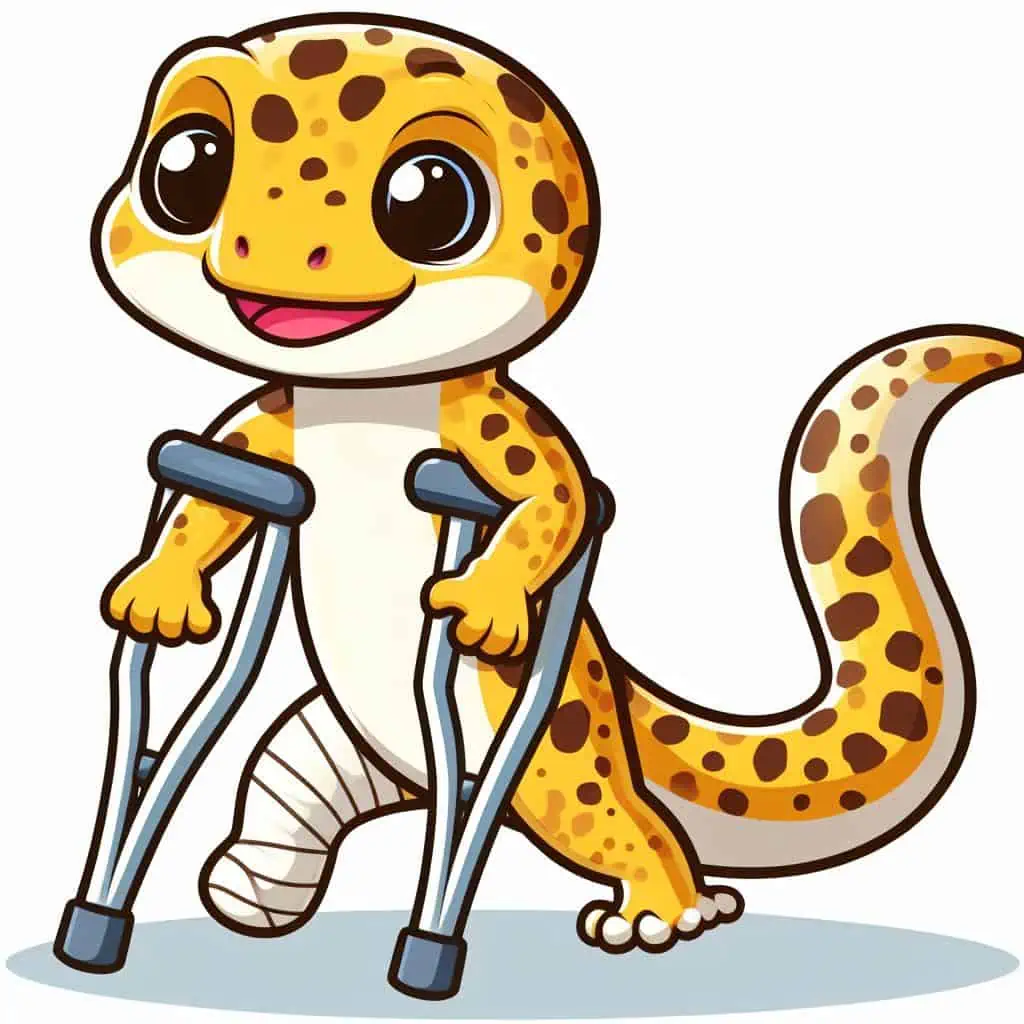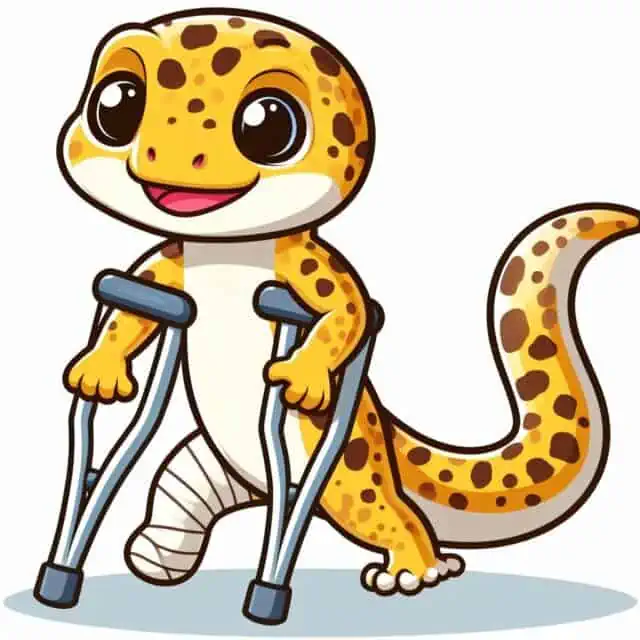A leopard gecko with a broken leg is a concerning sight for any reptile owner. Broken legs in these reptiles can be a result of various factors, but one primary reason stands out: metabolic bone disease. This condition, stemming from insufficient calcium metabolism, makes their bones brittle and prone to fractures. Young leopard geckos are especially susceptible to this ailment. When affected, they often display reduced appetite and experience mobility issues.
MBD and Diet: Metabolic Bone Disease (MBD) is a leading cause of broken legs in leopard geckos. Combat this by ensuring a calcium-rich diet, dusting food with calcium powder 2-3 times weekly.
Early Detection: Watch for signs like limping, head or limb shaking, and appetite loss in your gecko. Immediate veterinary care is crucial upon observing these symptoms.
Home Care Essentials: Balance in diet and consistent UVB light exposure are foundational. UVB light plays a role in calcium metabolism, fortifying your gecko’s bones.
Professional Care: While home measures are important, prioritize professional diagnosis and treatments, such as splinting or pain medications.
Prevention Strategies: Regular vet visits, maintaining a nutritious diet, and staying attuned to your gecko’s behavior can prevent injuries and promote overall well-being.
Possible Causes of Broken Leg in Leopard Geckos
One of the leading causes of broken legs in leopard geckos is metabolic bone disease (MBD). MBD arises from insufficient calcium metabolism. This deficiency leads to the gecko’s bones becoming brittle, increasing the likelihood of fractures and breaks.
Young reptiles are particularly at risk. Metabolic bone disease is often diagnosed in younger geckos. When affected, these young reptiles display notable symptoms. They may experience a significant loss of appetite and encounter mobility issues. These signs, combined with a fragile skeletal structure, make them more susceptible to injuries like broken legs.
Common Symptoms of a Broken Leg in Leopard Geckos
Identifying a broken leg in leopard geckos is crucial for their well-being. While physical signs might be the most obvious indicators, there are also behavioral changes to watch out for. Recognizing these symptoms early can lead to faster intervention and better chances of recovery.
Visible Signs of Injury
When a leopard gecko sustains an injury, certain visible signs can be observed. One of the most telling symptoms is the gecko displaying unusual behaviors like shaking of the head or limbs. Additionally, twitching or running with a noticeable limp can be clear indicators of distress or pain.
Injuries aren’t just limited to their legs. Damage to their spine, tail, or other limbs can lead to more severe mobility challenges. You might notice your gecko dragging its back legs or favoring the uninjured leg while moving. Moreover, injuries to the head or spine can have a profound effect on their overall mobility, making it difficult for them to navigate their environment.
Behavioral Changes
A leopard gecko with a broken leg will often show distinct behavioral changes. Owners should be vigilant and monitor their gecko’s typical routines and habits. One of the first signs to look out for is a change in activity level. A gecko that was once active and lively might become lethargic or show decreased enthusiasm for exploring its environment.
Changes in movement are also telltale signs. The gecko might have difficulty climbing or might start dragging the affected leg. Additionally, their appetite might wane, showing less interest in food than usual.
Painful When Touched or Moved
Identifying a broken leg in a leopard gecko often involves observing its reaction when touched or moved. A clear sign is if the gecko displays pain or discomfort during these interactions.
Even in the absence of visible swelling, the gecko might try to pull away or cringe when handled. Such reactions are not typical and can indicate underlying pain or injury.
It’s essential to act on these signs promptly. If you suspect your gecko is in pain, it’s crucial to seek veterinary treatment.
Diagnosing a Broken Leg in a Leopard Gecko
Accurate diagnosis is paramount when suspecting a broken leg in a leopard gecko. While observations and behavioral cues can provide initial insights, a thorough examination by a veterinary professional is essential.
Taking the Reptile to the Vet
When you suspect your leopard gecko has a broken leg or shows signs of Metabolic Bone Disease (MBD), it’s imperative to take it to the vet. Early intervention can make a significant difference in the prognosis and recovery. A veterinarian possesses the knowledge and tools to make an accurate diagnosis based on clinical examinations and tests.
An accurate diagnosis is the foundation for effective treatment. Veterinary professionals will provide tailored treatment options suitable for the gecko’s condition. For a broken leg, the vet might suggest splinting the leg to aid in the healing process. If the gecko is in pain, appropriate pain medications can be administered to provide relief.
If the underlying cause is a calcium deficiency leading to MBD, the vet will recommend dietary changes and supplements to address the root of the problem.
Home Care and Prevention
Caring for a leopard gecko with a broken leg doesn’t end after a visit to the vet. Home care plays an essential role in the recovery and overall well-being of the reptile. A critical aspect of home care involves ensuring the gecko receives a proper diet and necessary supplements. This is especially vital if the injury resulted from underlying conditions like Metabolic Bone Disease (MBD), which can also lead to underbite in leopard geckos, among other things.
One of the primary steps to prevent MBD is to address dietary calcium deficiencies. Owners can achieve this by dusting the gecko’s food with calcium powder two to three times a week. This ensures the reptile gets the necessary calcium intake for robust bone health. Alongside dietary measures, it’s crucial to provide adequate UVB light exposure. Whether it’s through natural sunlight or UVB lights, this exposure facilitates calcium metabolism in the gecko’s body, further fortifying its skeletal system.
In conclusion, while home care practices like ensuring a proper diet and UVB exposure are crucial, it’s equally important to remain vigilant. If any symptoms suggestive of Metabolic Bone Disease (MBD) are observed, seeking immediate veterinary assistance is paramount.






